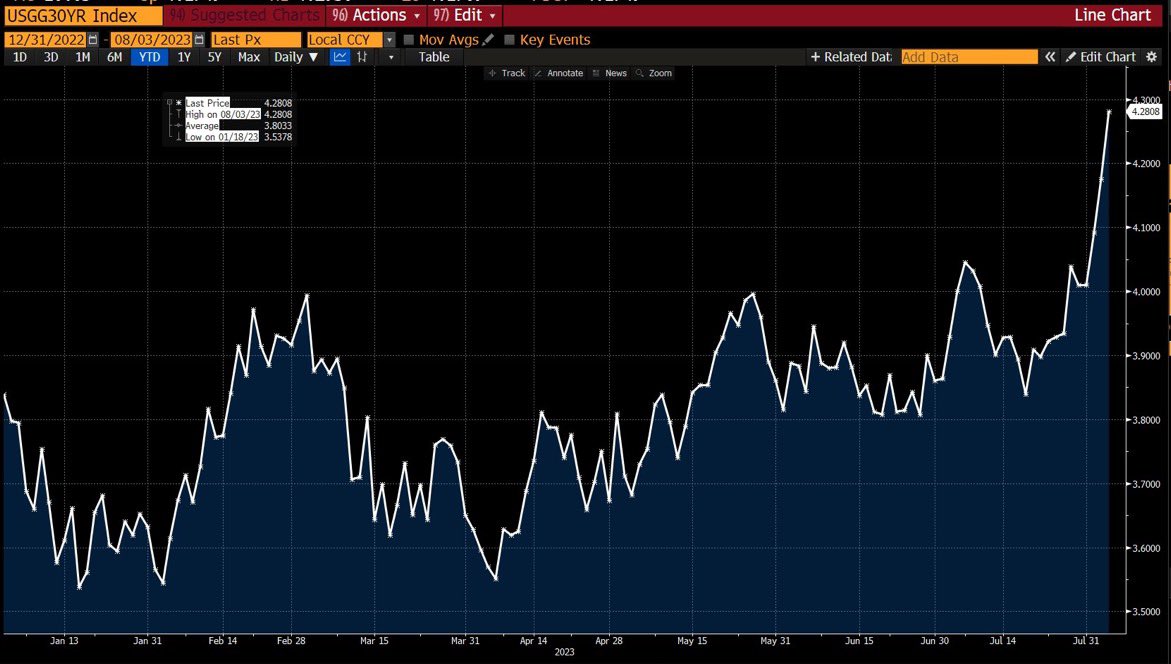[ad_1]
What does this imply for Bitcoin and the broader crypto market? In a stunning transfer that has despatched ripples by the monetary world, billionaire hedge fund supervisor Invoice Ackman not too long ago introduced that he’s shorting 30-year Treasury payments. Ackman predicts that yields might quickly skyrocket to five.5%, a transfer he’s positioning as a hedge towards the affect of long-term charges on shares in a world he believes will likely be characterised by persistent 3% inflation.
“I’ve been stunned how low US long-term charges have remained in mild of structural modifications which are prone to result in increased ranges of long-term inflation,” Ackman wrote on Twitter. He cited elements resembling de-globalization, increased protection prices, the vitality transition, rising entitlements, and the higher bargaining energy of staff as potential drivers of this inflation.
Ackman additionally pointed to the overbought nature of long-term Treasurys and the growing provide of those securities as a result of U.S.’s $32 trillion debt and enormous deficits. “Once you couple new issuance with QT, it’s arduous to think about how the market absorbs such a big improve in provide with out materially increased charges,” he added. Remarkably, the 30 yr yield climbed to 4.28% yesterday.

Nonetheless, not everybody agrees with Ackman’s perspective. Ram Ahluwalia, CEO of Lumida Wealth, recommended that Ackman’s views may already be priced into the market. “When somebody has an thought, particularly a hedge fund supervisor, it’s good psychological behavior to imagine the thought is Consensus,” Ahluwalia wrote on Twitter. He even recommended taking the alternative view, advocating for getting 10-year bonds within the 4.1 to 4.25% vary and mortgage bonds at 6.5 to 7%.
In the meantime, Lisa Abramowicz, a Bloomberg analyst, noted that the U.S. Treasury selloff has been pushed by long-dated notes, not these most delicate to Fed coverage. “This means two issues: merchants count on inflation to remain increased for longer they usually query whether or not the Fed is really going to boost charges excessive sufficient to attain 2% inflation,” she mentioned.
Implications For Bitcoin And The Crypto Market?
Because the opinions are divergent and, furthermore, Bitcoin and bond yields are linked in a number of methods, there are a number of potential situations.
State of affairs 1: Yields Rise Considerably
If Invoice Ackman’s prediction comes true and the yield on 30-year Treasury payments rises considerably to round 5.5%, this might have a number of implications for Bitcoin.
Elevated Danger Urge for food: Larger bond yields might point out a higher threat urge for food amongst buyers. If buyers are prepared to just accept increased threat for increased returns, they could even be extra inclined to spend money on Bitcoin, which is commonly seen as a riskier asset. This might probably drive up the value of Bitcoin.
Inflation Hedge: If the rise in bond yields is pushed by elevated inflation expectations, Bitcoin might appeal to extra funding as a possible retailer of worth. Bitcoin, sometimes called ‘digital gold’, has been seen by some buyers as a hedge towards inflation. If inflation continues to rise and erodes the worth of fiat currencies, extra buyers may flip to Bitcoin, pushing its worth increased. Nonetheless, that’s a story that also must be confirmed over time.
Moreover, it’s vital to notice that if yields rise too rapidly or too excessive, it might result in a sell-off in threat belongings, together with Bitcoin, as buyers transfer to safer belongings. This might probably put downward strain on Bitcoin’s worth.
State of affairs 2: Yields Stay Steady Or Fall
If, opposite to Ackman’s prediction, yields stay secure or fall, this might additionally affect Bitcoin.
Danger Aversion: Decrease yields might recommend that buyers are shifting in direction of safer belongings, which might negatively affect Bitcoin costs. If buyers are much less prepared to tackle threat, they could transfer away from Bitcoin in direction of safer belongings like bonds.
Liquidity Situations: Bond yields can replicate liquidity situations out there. If yields fall, it might recommend that liquidity is excessive. In such a state of affairs, there might be extra capital obtainable for funding in belongings like Bitcoin, probably supporting its worth.
State of affairs 3: Market Uncertainty Will increase
If market uncertainty will increase, for instance on account of issues about U.S. fiscal coverage or fast repricing within the bond market, Bitcoin might probably function a hedge.
Hedge Towards Uncertainty: In instances of market uncertainty, like within the banking disaster in March, some buyers may flip to Bitcoin as a possible hedge. If Bitcoin’s perceived standing as a ‘digital gold’ or protected haven asset strengthens, this might probably appeal to extra funding and drive up its worth.
Nonetheless, it’s vital to notice that Bitcoin’s response to market uncertainty will be unpredictable and may rely upon a wide range of elements, together with investor sentiment and broader market situations.
In conclusion, the potential affect of bond yield actions on Bitcoin’s worth is complicated and may rely upon a wide range of elements. Buyers ought to stay vigilant and take into account a variety of potential situations.
In any other case, Bitcoin and crypto intrinsic elements just like the approval of a Bitcoin spot ETF, a Ether futures ETF or any actions by the US Division of Justice (DOJ) towards Binance, amongst others, have the potential to trigger an elevated volatility.
Featured picture from CNBC, chart from TradingView.com
[ad_2]
Source link


